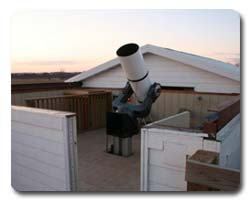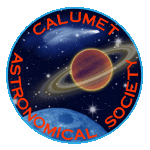Navigate

Conway history
The emphasis on ADA compliancy drove a number of design features. Compliance set a minimum size on the restroom, and this in turn set the width of the restroom and control room. Several different telescopes were considered for this observatory's main instrument, and the Meade 16" LX200 was selected. This telescope gave the best balance between optical power and maximum convenience for users. The Friends of the Indiana Dunes conducted a fund raising campaign,raising $8,000 to purchase a Pier-Tech elevating pier for the telescope. This allows the telescope eyepiece to be set at a very comfortable height for all observers and allows the telescope to reach the horizon in the east, south, and west directions if desired - a very unusual feature in a roll off type observatory. Construction at Burns Harbor moved forward, and by the end of 2001, the basic building was complete. By this time, however, DNR had entered a funding crisis and was unable to complete their end of the deal. The building sat on its construction foundation at Burns Harbor until 2005, when an initiative by the Calumet Astronomical Society resulted in a deal to locate the observatory on a 40 acre parcel owned by the Lake County Parks south of Buckley Homestead County Park near Lowell, Indiana. A fund raising campaign spearheaded by Dr. Robert Cornwell provided sufficient funding to build the foundation, put in electrical power, and get the building moved to its site. The observatory was formally dedicated on Labor Day 2005 and is named after Thomas Conway, former head of the ICD program for the United Steelworkers of America and their current Vice President. Much work has been done to Conway Observatory over the last four years, and in many ways it has exceeded its design potential. While the observatory was originally conceived as a single level building, the site terrain and funding obtained allowed a walk out basement to be included. The doors to this basement open out in to a 60' diameter concrete circle. This has proved very effective in promoting social amateur astronomy, with CAS members parking their vehicles around the edge of this circle and setting their telescopes up on the pad. The increase in height of the building led to challenges in the design of the handicap access ramps, and these were designed by CAS member Thomas Pappalardo. Lumber for their construction was donated by Tri-Creek Lumber of Lowell, Indiana, and construction was done entirely by CAS volunteers. In February 2006, a tornado struck the uncompleted observatory and blew off the roof. A new roof was designed and built by CAS volunteers. CONTINUED.....
observatory. Construction at Burns Harbor moved forward, and by the end of 2001, the basic building was complete. By this time, however, DNR had entered a funding crisis and was unable to complete their end of the deal. The building sat on its construction foundation at Burns Harbor until 2005, when an initiative by the Calumet Astronomical Society resulted in a deal to locate the observatory on a 40 acre parcel owned by the Lake County Parks south of Buckley Homestead County Park near Lowell, Indiana. A fund raising campaign spearheaded by Dr. Robert Cornwell provided sufficient funding to build the foundation, put in electrical power, and get the building moved to its site. The observatory was formally dedicated on Labor Day 2005 and is named after Thomas Conway, former head of the ICD program for the United Steelworkers of America and their current Vice President. Much work has been done to Conway Observatory over the last four years, and in many ways it has exceeded its design potential. While the observatory was originally conceived as a single level building, the site terrain and funding obtained allowed a walk out basement to be included. The doors to this basement open out in to a 60' diameter concrete circle. This has proved very effective in promoting social amateur astronomy, with CAS members parking their vehicles around the edge of this circle and setting their telescopes up on the pad. The increase in height of the building led to challenges in the design of the handicap access ramps, and these were designed by CAS member Thomas Pappalardo. Lumber for their construction was donated by Tri-Creek Lumber of Lowell, Indiana, and construction was done entirely by CAS volunteers. In February 2006, a tornado struck the uncompleted observatory and blew off the roof. A new roof was designed and built by CAS volunteers. CONTINUED.....

